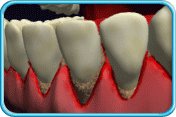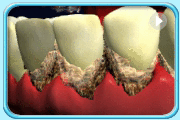Gum Disease (Periodontal Disease)
The early signs of gum disease are redness and swelling of the gingivae which also bleed easily. However, it should better be confirmed by the dentist's diagnosis.
Mild gum disease
Symptoms
- Gingival margin is red and swollen.
- Gingivae (gums) bleed easily upon toothbrushing.
- Calculus may be accumulated.
- The teeth or gingivae may be painful.
-
May have bad breath.
Management
- Use oral care products such as toothbrush, dental floss, etc., to remove the dental plaque every day in the morning and before bed at night.
- If calculus is present, have it removed by scaling by the dentist in order to facilitate your daily removal of dental plaque.
Then, the area with mild gum diseasee will heal by itself.
Moderate gum disease
Symptoms
- Gingival margin shows marked redness and swelling.
- Gingivae always bleed upon toothbrushing.
Gingival margin recedes, leading to the exposure of the root of the tooth and the tooth looks longer.
-
Periodontal pocket is formed. (The inflammation of the tissues surrounding the tooth leads to the destruction of periodontal membrane. The tooth surrounding tissues and the root of the tooth become detached and a periodontal pocket is formed in between.)
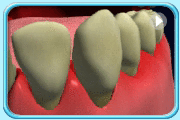 A periodontal probe is inserted into a periodontal pocket
A periodontal probe is inserted into a periodontal pocket
- Calculus is accumulated.
- May have bad breath.
- The teeth or gingivae may be painful.
Management
- Consult a dentist immediately for scaling to remove the calculus and the dental plaque in the periodontal pocket. After the removal of calculus, it will be easier to thoroughly remove the dental plaque.
- Use oral care products such as toothbrush, dental floss, etc., to remove the dental plaque every day in the morning and before bed at night in order to prevent gum disease from progressing or recurring.
- After treated by a dentist, you must maintain good oral care habits and visit the dentist regularly for dental check-up.
Severe gum disease
Symptoms
Management
- See a dentist immediately for:
- Scaling to remove the calculus;
- Root planing or periodontal surgery to remove the dental plaque and calculus on the roots of the teeth and in the periodontal pockets;
- Receive antibiotic therapy as needed.
- Use oral care products such as toothbrush, dental floss, etc. to thoroughly remove dental plaque every day in the morning and before bed at night so as to control the progression of the disease.
- After treated by a dentist, you must maintain good oral care habits and visit the dentist regularly for dental check-up.
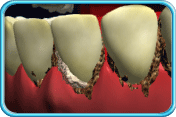
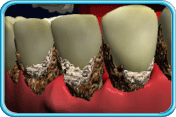
 A periodontal probe is inserted into a periodontal pocket
A periodontal probe is inserted into a periodontal pocket